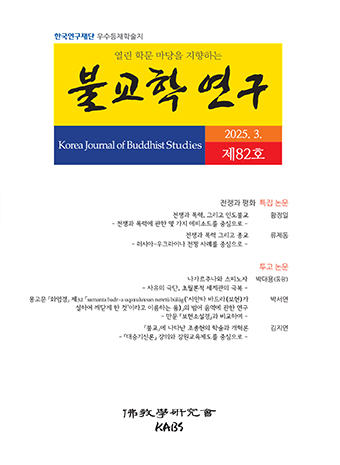- 영문명
- The Development and Implications of the Buddha-nature of Insentient Beings in Ch’an (Sŏn/Zen) Thought
- 발행기관
- 불교학연구회
- 저자명
- 마해륜(Hae-Ryoon MA)
- 간행물 정보
- 『불교학연구』제84호, 53~85쪽, 전체 33쪽
- 주제분류
- 인문학 > 불교학
- 파일형태
- 발행일자
- 2025.09.30
6,760원
구매일시로부터 72시간 이내에 다운로드 가능합니다.
이 학술논문 정보는 (주)교보문고와 각 발행기관 사이에 저작물 이용 계약이 체결된 것으로, 교보문고를 통해 제공되고 있습니다.

국문 초록
초목불성은 동아시아에서 특수한 형태로 전개된 불성 사상이다. 교학 전통에서 정영사(淨影寺) 혜원(慧遠, 523-592)의 『대승의장』에서 불성을 능지성(能知性)과 소지성(所知性)으로 구분하고, 대상 세계에 존재하는 불성을 인정할 수 있는 단초를 제공한것이 그 사상적 기원이다. 삼론종 『대승현론』에서는 제한적으로 초목불성을 인정했는데, 중도를 체득한 리내(理內)의 범주에서는 중생과 일체 초목도 모두 불성이 있고, 성불할 수 있다고 하였다. 이것은 불성의 존재론적 정당화가 아니라 유정과 무정을구분하고 불성의 유무를 가르는 분별을 해체하기 위한 역설적 논변이다. 기존에 선사상 연구에서 초목불성은 주로 우두종을 중심으로 다루어져 왔으며, 도가적 자연관과결합된 불성론으로 간주되는 경향이 있었다. 그러나 북종계 『능가사자기』에는 구나발다라와 보리달마에게 화두의 원초적 형태로 무정설법을 활용하여 학인의 경지를점검하고 깨달음으로 유도하는 선법이 발견된다. 도신(道信)은 경전에 대한 고착적이해를 극복하는 소재로 초목불성을 예시하고 있으며, 홍인(弘忍)은 무정의 세계를 아뢰야식이 실현된 경계법신(境界法身)으로 설명했다. 우두종은 초목이 본래 도와 합치된 존재로서 성불할 수 있다고 보았고 『화엄경』과 『유마경』과 같은 경전을 근거로삼았다. 우두종의 초목불성은 남종의 불성에 대한 비판을 목적으로 등장했으며, 불성의 소지성(所知性)과 능지성(能知性)을 모두 인정하는 경향을 보인다. 이후 『조당집』에 서술된 혜충국사의 무정불성은 남종의 특정 분파에서 발생한 경도된 불성 해석을비판하기 위한 서사로서 남종 내부의 관점이 투영된 것으로 이해할 수 있다.
영문 초록
The theory of the Buddha-nature of insentient beings represents a distinctive development in the discourse on Buddha-nature within East Asia. This idea was debated in the doctrinal traditions of the Sanlun, Tiantai, and Huayan schools. Its origins can be traced to Huiyuan (慧遠, 523–592) of Jingying Temple in the Dilun school, whose Dasheng Yizhang (大乘義章) articulated a distinction between Buddhanature as “the nature of knowing” and “the nature of being known,” thereby providing a foundation for acknowledging Buddha-nature as existing within the objective world. In the Sanlun (三論) school’s Dasheng Xuanlun (大乘玄論), it was argued that once the Middle Way is realized, all sentient beings and even plants possess Buddha-nature and can achieve Buddhahood. This is not an ontological justification of Buddha-nature, but a paradoxical argument intended to deconstruct discriminative cognition that distinguishes between sentient and insentient beings and determines the presence or absence of Buddha-nature.
In Chan thought, numerous examples appear in the Northern school’s Lengqie Shizi Ji, where the Dharma teaching of insentient beings was employed as an unconventional Chan method to test students and guide them toward enlightenment. Guṇabhadra and Bodhidharma also made use of insentient Dharma teaching, which later developed into huatou. Daoxin employed the Buddha-nature of insentient beings as a means to overcome rigid scriptural interpretation, while Hongren described the realm of insentient beings as the dharma-body (境界法身), where the sphere of ālayavijñāna is realized. The Ox-head school taught that plants are beings originally united with the Dao (道) and capable of attaining Buddhahood, drawing on scriptures such as the Avataṃsaka Sūtra and the Vimalakīrti Sūtra for textual support.
The Ox-head school’s theory of the Buddha-nature of plants carried critical implications for the Buddha-nature debate, opposing the Southern school’s interpretations. It displayed a tendency to affirm both the “knowable nature” (所知 性) and the “knowing nature” (能知性) of Buddha-nature. The attribution of the Buddha-nature of insentient beings to National Master Huizhong in the Zutangji (祖 堂集) can be read as a narrative reflecting the Southern school’s internal perspective, which sought to criticize the extreme interpretations of Buddha-nature that had emerged within its own branches.
목차
I. 서론
II. 초목불성의 교학적 논리
III. 『능가사자기』에서 초목의 의미
IV. 우두종의 초목불성
V. 남양혜충의 무정설법
VI. 맺음말
참고 문헌 REFERENCES
키워드
해당간행물 수록 논문
- 선사상에 나타난 초목불성의 전개와 함의
- 불교 언어철학의 전개 - 초기불교에서 『중론』까지
- 『유가론기(瑜伽論記)』에 나타난 현장(玄奘)의 학문적 위상
- 고려 사경(寫經), 젠더로 읽다 - 『묘법연화경』사경으로 본 여성의 성불과 좌절
- 초기 유가사 수행의 현대적 해석을 통한 트라우마 치유 가능성 모색 - 『수행도지경』을 중심으로
- 인성교육 주체 간 신뢰회복의 중요성 - 『대승기신론』의 수행체계를 중심으로
- 불성의 형이상학
- 『능가경』은 여래장과 알라야식을 동일시했는가?
- 물리적 대상만이 공간을 점유하는가? - 유가행 유식학파 철학에서 공간성의 문제 재검토
- 『대승기신론』의 물과 바람과 파도의 비유 연구
- “무대 위의 꼭두각시를 보라” - 임제의 삼구·삼현·삼요와 동산의 삼로를 중심으로
- 원효의 상위비량을 통한 법상유식 무성론 비판 연구 - 규기의 무성유정 인명논증을 중심으로
- 역사적 붓다의 본성에 대한 재고찰 - 초기 불교 문헌을 완성된 전체로 파악하는 접근법에 입각하여
참고문헌
교보eBook 첫 방문을 환영 합니다!

신규가입 혜택 지급이 완료 되었습니다.
바로 사용 가능한 교보e캐시 1,000원 (유효기간 7일)
지금 바로 교보eBook의 다양한 콘텐츠를 이용해 보세요!



